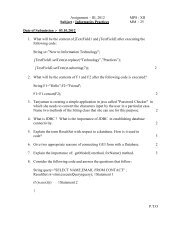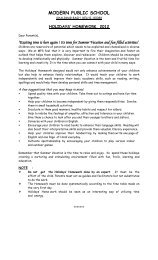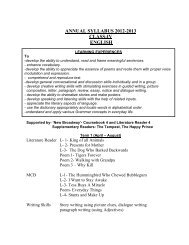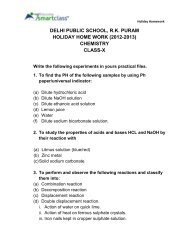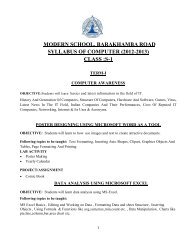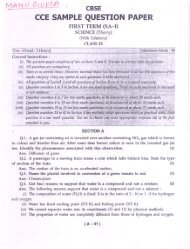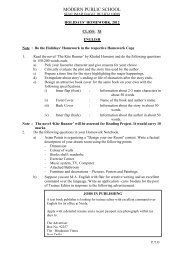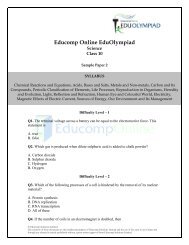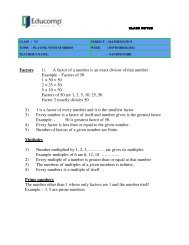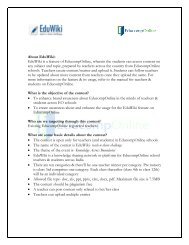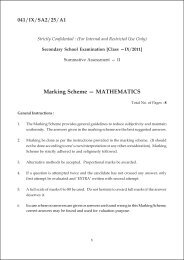Hardayal Public School Holiday Assignment of ... - Educomp Online
Hardayal Public School Holiday Assignment of ... - Educomp Online
Hardayal Public School Holiday Assignment of ... - Educomp Online
You also want an ePaper? Increase the reach of your titles
YUMPU automatically turns print PDFs into web optimized ePapers that Google loves.
long did the current flow? What mass <strong>of</strong> copper and <strong>of</strong> zinc were deposited? Atmasses <strong>of</strong> Ag, Cu, Zn are 108 u, 63.5 u and 65 u respectively.Chapter – 4 Chemical Kinetics1. Give the units <strong>of</strong> rate constant <strong>of</strong> 1st order, 2nd order, 3rd order and nth orderreaction.2. What is a first order reaction? Give two examples.3. Derive expression for the rate constant <strong>of</strong> the first order reaction. Show that log[A] is a linear function <strong>of</strong> time.4. How can the plot <strong>of</strong> log [A] and t be used for the calculation <strong>of</strong> rate constant forthe first order?5. What would be probable plot <strong>of</strong> conc. vs. time for zero order reaction?6. What is meant by half life period?7. The rate <strong>of</strong> a reaction is given by equationRate = k[A]2[B]What are the units <strong>of</strong> the rate and rate constant for this reaction?8. Explain the following :(i) activation energy (ii) threshold energy(iii) activated complex9. The decomposition <strong>of</strong> a compound is found to follow a first-order rate law. If ittakes 15 minutes for 20 percent <strong>of</strong> original material to react, calculate (i) thespecific rate constant, (ii) the time at which 10 percent <strong>of</strong> the original materialremains unreacted, (iii) the time it takes for the next 20 percent <strong>of</strong> the reactantleft to react first 15 minutes.10. Find the two-third life, t 2/3 , <strong>of</strong> a first order reaction in which k = 5.4 × 10 –14 s –1 .Chapter – 5 Surface Chemistry1. What is the effect <strong>of</strong> temperature on adsorption?2. What is heterocatalysis?3. Give one example <strong>of</strong> a peptizing agent.4. Write a short note on adsorption. How does it differ from absorption?5. What is adsorption? Write any two features that distinguish physisorption fromchemisorptions.6. On what factors does adsorption <strong>of</strong> gases on solids depend?7. What are isotherms and isobars? What is the difference between isotherms <strong>of</strong>physisorption and chemisorptions?8. What do you understand by the terms(i) Catalyst (ii) Promoter (iii) Poison.Give one example <strong>of</strong> each.9. Give two chemical methods for the preparation <strong>of</strong> colloids.10. Give two physical methods for the preparation <strong>of</strong> colloids.11. Write brief note on :(i) Coagulation (ii) Gold number (iii) Hardy-Schulze rule12. Explain the following terms :(i) Lyophobic sols (ii) Gold number (iii) Peptisation



